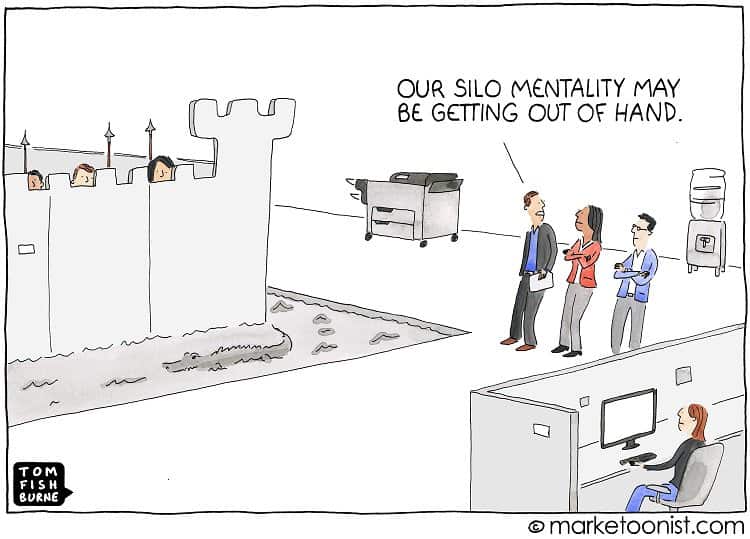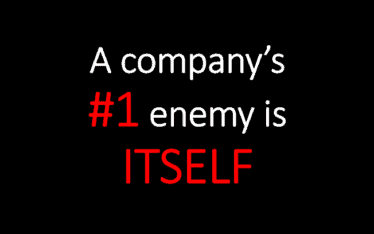Silos can play a harmful role – Breaking down organizational silos
One of the biggest barriers to business transformation are the dreaded silos. Silo thinking is the real innovation and agility killer
Business silos can occur in global corporations or start-up ventures with just a few employees. And no matter the size, they are detrimental to an organization’s ability to succeed in a rapidly changing world.
Business silos, just like agricultural silos hold something important and make it hard to get at. That’s good when one is protecting wheat and corn from rain & snow.
But it’s bad when one is trying to change across departments and divisions. And the bigger the company the more harmful a role silos play. Silos create an environment where sharing and collaborating for anything other than one silo’s special interests is virtually impossible.

One of the biggest barriers to business transformation are the dreaded silos. Silo thinking is the real innovation and agility killer. Organizational change require breaking down silos.
A siloed organization cannot act quickly on opportunities
Remember! Companies don’t change because they want to. They change because they are forced to by customers, by competition, by advances in science and technology and by government regulation.
Overcome organizational silos
But it doesn’t work unless leadership leads and helps everyone understand why change must happen and why they need to work together in new and different ways toward a common goal.
Creating a compelling case for change is a critical step in breaking down silos. Try to guess who said the following, and when:
It must be considered that there is nothing more difficult to carry out, nor more doubtful of success nor dangerous to handle, than to initiate a new order of things. For the reformer has enemies in all those who profit by the old order, and only lukewarm defenders in all those who would profit by the new order, this lukewarmness arising partly from fear of their adversaries, who have the laws in their favor, and partly from the incredulity of mankind, who does not truly believe in anything new until they have had experience of it.
The quote was from Niccolò di Bernardo dei Machiavelli, in 1513. And not much has changed in 500 years! Only by inspiring the entire organization with a compelling case for why it needs to change in order to insure the future health and growth of the enterprise … and job security (what’s in it for me?) will anyone be willing to play with speculation, risk-taking and newness.
A siloed organization cannot act quickly on opportunities that arise in a fast-paced business landscape, nor is it able to make productive decisions about how to change in order to seize these opportunities.
A silo mentality can be a contributing factor to a failing corporate culture
A silo mentality reduces efficiency and can be a contributing factor to a failing corporate culture. To eliminate silos it can be a good idea to bring people across the organization together. There are several ways that can be done – “Blind-Date” is just one of them!

The speed of change will require companies to work very differently in the future – with shorter decision cycles, more employee engagement and stronger collaboration than had previously been required to compete.
Short URL & Title:
Organizational change require breaking down silos — https://www.torbenrick.eu/t/r/pdc
Share it:
If you enjoyed this article, please take 5 seconds to share it on your social network. Thanks!








Torben, I agree with your concern about silos hurting a company’s ability to change. An unintended consequence of Key Performance Indicators, is that they can reinforce the various silos, as many KPIs are silo specific. I saw this in a large mining company I worked with, that had 213 different KPIs, and predictably, a lot of internal strife. To counter this, providing employees with a common goal that cuts across the silos is quite powerful.
Torben, as usual interesting article. silos are the mind killers of companies, people stop thinking about the interconnections and that they are all interdependent. kPI especially too many will add to this barrier to flow and flexibility in responding to changing demands and situations in the market. The compelling reason need not be something big, it can be more personal decision making, dealing with new skills, proving learning to others from outside your silo. These and other events such as Kaizens will give people the chance to move outside their silos without exposure, leading to change. But as you rightly say it depends on a leadership that is committed.
Torben, great article and i agree with your position.
I worked for a (large company which was extremely siloed and the behaviours of the various parts of the business were at direct odds with each other; Price vs. Cost being the biggest one.
We also had the situation coming up to the Financial year-end where the cry was “REDUCE INVENTORY”, which in their terms meant push it back to the supplier – because you’ve ordered too much in the first place (to get a good price). That’s not great anyway, think of all the Muda. But when your supplier is another part of the same business…..
I find that the causes are usually management driven (from individual departmental targets), the rest just cascades down to the organisation below!
I have never had a problem in past roles giving time and budget if there is little gain for me (and my department) and huge gain to the recipient!
So the lesson is, The Price is NOT the Cost – and as an old BT advert said over 20 years ago; it’s good to talk!
I hope this makes sense.
A
I agree communication is the key factor however there’s more to it than simple fear. We need to understand what’s driving the fear.
Invariably an individual’s performance is measured on what they personally have achieved and this process can foster unsavoury behaviours which only serves to exacerbate the silo mentality. If that individual perceives it is their sole responsibility to deliver an objective and they imagine they will be rewarded handsomely for delivering it or vice versa if they don’t, it can foster a fear of what others may do to weaken their own position. This fear can turn contribution by others into a perceived threat and indeed in some cases the situation may even foster the stealing of ideas which is where miss-communication plays a factor if the person stealing the idea doesn’t fully understand what it is they have stolen. A short residency course at the Cranfield School of Management opened my eyes on the plethora of tactics employed by people leading to the causes of silo’s.
So Silo’s is not simply a product of bad communication. In my view it is much deeper than that and it’s a product of how we measure performance. In setting performance objectives Managers have an important part to play in breaking down the silo’s and this is achieved very simply by managers not only focusing performance measurement on the end result but also measuring how the individual arrived at that result. The analogy to explain this takes me back to my mathematics & physics exams where I was told; show your working out because even if you get the answer wrong you will still get marks for your working out.
Therefore, I believe if we want to break up the silo mentality then it needs every single manager when they’re having their 1-2-1’s with their staff to focus more on how a person is achieving their objective not just the end result. It may transpire their member of staff hasn’t got the skill set to deliver the objective they set them but, if that person engaged the people that do have the skill set and the objective was achieved then they should be rewarded accordingly.